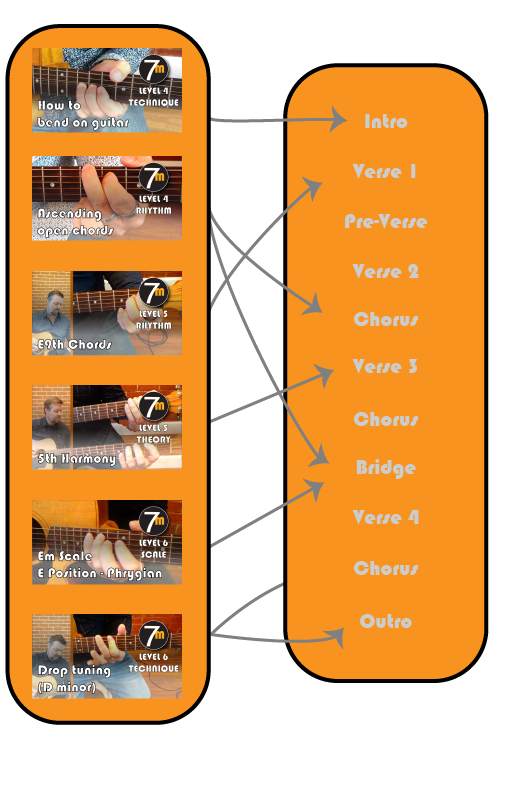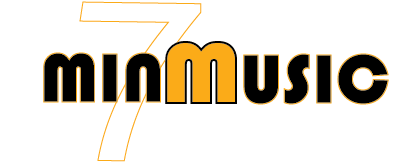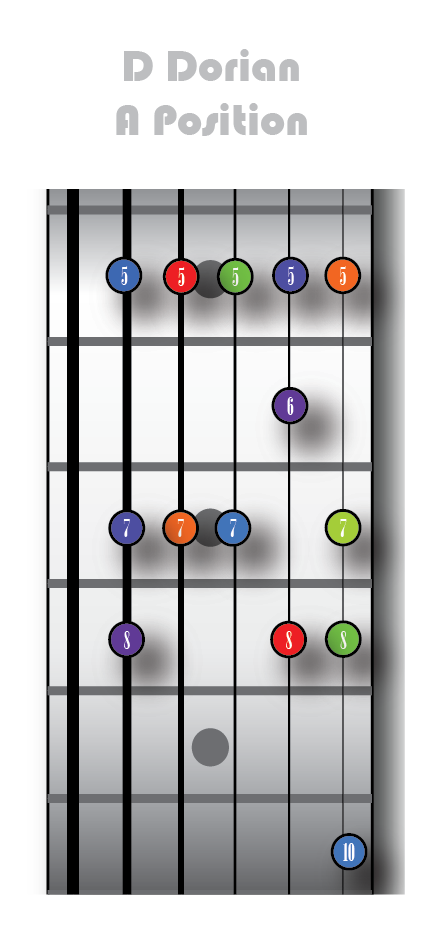Learn how to use online guitar lessons to write a song: Part 1 – Breaking down a song
Online guitar lessons are a bit hit and miss – lots of sites and channels just have lessons on how to play other peoples songs and a few tricks to help you along. Looking at the top online lessons they all take you through the basics along with a few chords that get you started. A few will have some excellent starter packs to get you playing but not really ever take you into writing your own music. So this series is trying to change that. We want new creators. Don’t get me wrong, learning other peoples songs is great to see what they have done, but without writing your own music you will always just be a copy. Dive in and start making music.
Part 1: Breaking down a song
Song used for analysis – So hard to breath
What we will do in this lesson is break down a freshly written song. This song has elements that have been taken directly from the guitar lessons on this site (7minutemusic.com). You may have heard the names of song structure elements before – verse, chorus, etc – these are the larger elements that we will construct using the component lessons. These include online guitar lessons from various different levels to give you a good overview of the different tools you have available. Future lessons on this series will bring things back down to concepts based on just 1 or two levels to let you work your way up to writing complex songs. Think of this as a showcase of what you can do once you have the skills from each lesson.

Introduction
With this song I came up with a melody that I took straight from a finger picking lesson. Finger picking is great for an introduction as its mellow but interesting. I often start with the verse and then go back to the intro but in this case I found the finger picking wasn’t to great with vocals but really set of the start of the song. With an introduction you are really trying to hook the listener. This can come in so many different ways but I really think that getting the hook of the song in straight away is best. Set the tone for the song. For this song its very layered with dynamic (volume) changes rather than chord changes (a technical explanation can be found here). The chord that I am using is the D sus 9th.
Verse
The verse is a good spot to start writing a song as you will generally either have a chord progression or melody that you have been playing around with as a base. I took the melody from the intro and changed it into a chord. Then it runs a bassline from the chromatic scale which is just going back one fret each bar. Something to note here as well is that it actually is in 3:4 (or 6:8 is you want to be technical). This gives the song a swinging rhythm that goes with the 4 bar line structure of the song. So we have a 4 sets of 6 notes being played for each line of the vocals. I love this as it gives you a familiar 4 bar structure that is easy to work with but the 3:4 ads an element of difference from a stock standard pop/rock structure. The descending run is essentially a bassline that I am using to create different interval harmonies and discord. You could also look at it like I am changing scales on the 4th bar which is similar to the harmonic minor slip – changing scale subtly for just a small moment can be awesome.
Lesson samples
Time Level 4 – 3:4 Timing
Theory Level 4 – Intervals
Scale Level 6 – Slipping Harmonic Minor
Chorus
The chorus is the lift in a song – its the exciting part that gets people singing. I really think that a chorus needs to be based around a vocal line. You can layer and lift a song to a chorus but getting that vocal to sit on top is what is key here. What I did here is flip my melody and descending bassline into power chords – 5ths. And I did that while keeping the D9th still running. How you ask? This is where drop tuning comes in. A power chord is just a root note and the 5th. When you drop the Low E-string down to a D you get a really easy flat bar finger powerchord. This is used extensively in metal but is really versatile in other genres too. So my bassline from earlier, which is really the main hook, becomes incorporated into the chord as the 5th of each chord. It adds so much depth and lets me strum the whole guitar where I play with the dynamics of the song.
Bridge
The bridge is essentially a break. Something different to separate the parts of a song. Pop music is notorious for using a key change where they go up a whole step for the bridge (It has died off thankfully but be aware – check here for some insights or here for some good examples in pop). I honestly find that so painful now – don’t do it, check out key changes more if you want to use them. In the bridge here I pull out some suspended chords which are easy to use with drop tuning. A tiny little tweak is included on the second chord where I throw in a natural 7th. Because this song is not really sticking to a key centre it just adds some colour to the chord without defining the song. If you want to match it with a scale then the D major fits here to explain it – if only for a moment. As the lead kicks in it is showcasing the Dorian mode. Particularly the A position of the D Dorian. It is just a stunning scale to solo in. It also really fits in this song which is playing with light and dark never really giving away which one it is. That is the Dorian summed up – light and dark in perfect balance.
Lesson samples
Theory Level 5 – Suspended and Added Chords
Scale Level 5 – Dm Dorian Scale – A position
Outro
Finishing a song is sometimes hard. I figured for this one I would just let it drift off. No particular reason. It has been a very dynamic driven song so I think the fade out will work. That said, this may well change from this recording which is a demo to the final product in a studio with multiple instruments involved. My point is don’t get hung up on a part so much that you are not willing to change it to make the song better. An outro is like an intro but it doesn’t need that hook. Its more looking to exit with style – don’t add unnecessary pieces to the song just for the sake of it. No real lessons for this one – its just a fade out the audio track.
How online guitar lessons can help build a song

Take home message
Write your own songs
- Start looking at how songs are structured
- Identify what skills are involved
- Look for lessons that teach the skills not the song
Audio track – So Hard to Breath
Try this scale over the track
The best online guitar lessons are the one that teach you skills
Skills are what get you better. I have made a heap of lessons that teach skills but you will also need to break down a few songs and start working out what they are doing. This lesson is a showcase – a lot of the lesson are higher level and may be difficult if you are just starting out. You can still start applying skills straight away though. The building blocks we use here – Rhythm, Theory, Scales, Technique and Timing – are essential to understand music. It’s not just chords and lead. Its not just cover songs. If you are just visiting 7 minute music or you are a member I really encourage you to write your own music. Look for online guitar lessons that teach you how to do more than just play a song. Once you learn a few skills then learn a song as well, you will understand so much more. We really don’t need the millionth version of hallelujah, what we need is some fresh creative music. So get writing and look for those lessons that teach you a bit more.
Looking for some good online guitar lessons to start song writing?
Check out these ones:




Leave A Comment